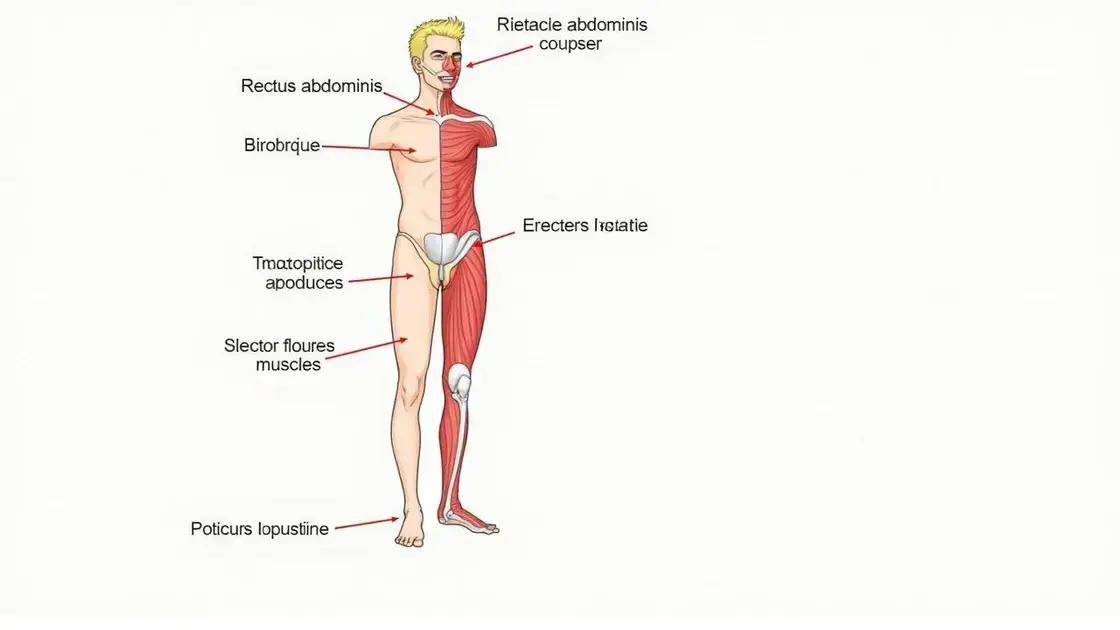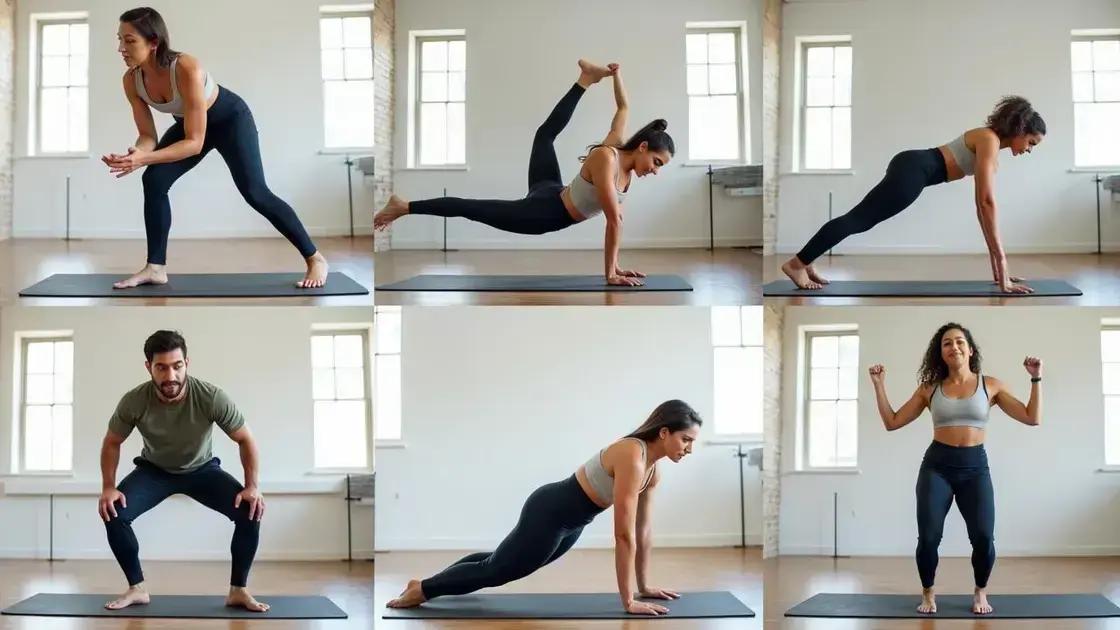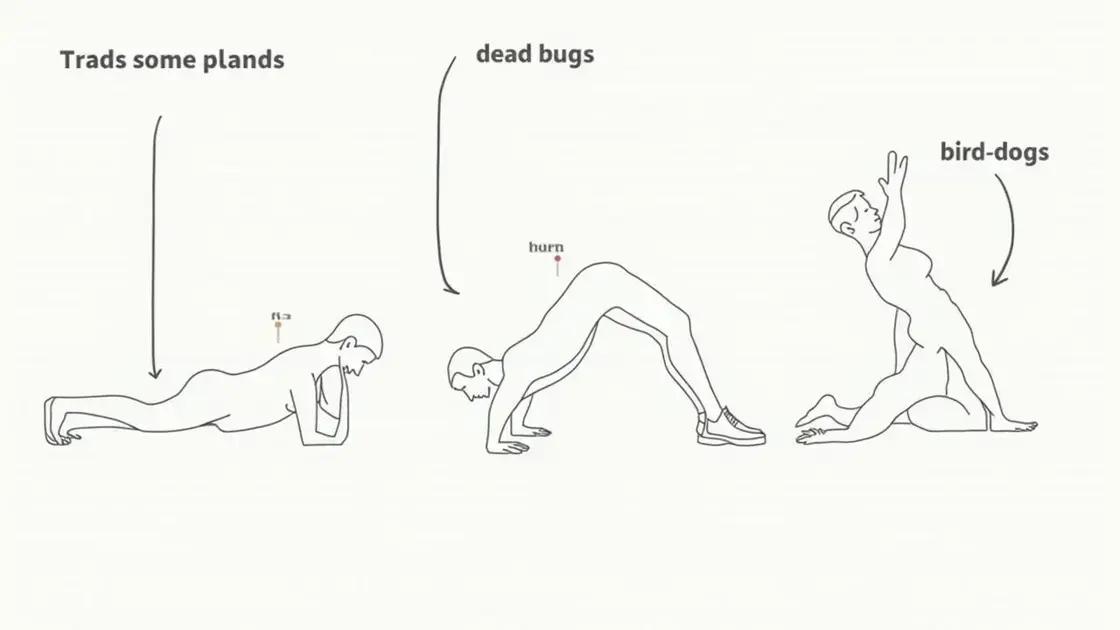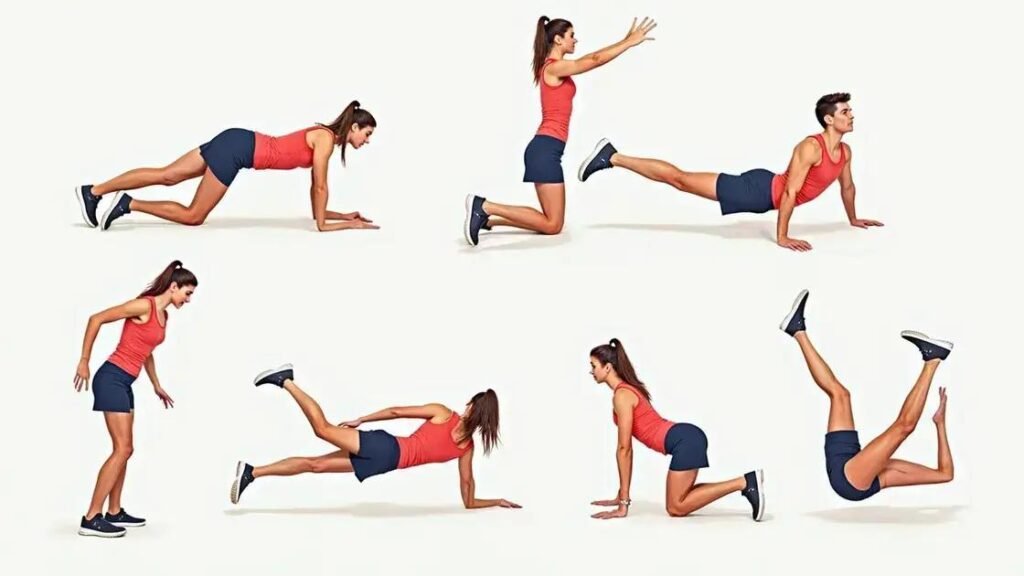Designing core workouts without crunches involves incorporating various effective exercises like planks, bird-dogs, and glute bridges, allowing you to strengthen your core safely while reducing the risk of injury. Aim for 2-3 sessions weekly, set clear goals, and track your progress to ensure continuous improvement.
Are you looking for ways to enhance your fitness routine? How to design core workouts without crunches is a popular question among fitness enthusiasts. Crunches can strain your back and neck, leading many to seek safer alternates. In this article, we will guide you through understanding core muscles, the benefits of non-crunch workouts, effective exercises you can try, and tips for designing your personalized core workout plan. Let’s dive in and strengthen your core safely!
Understanding Core Muscles

Understanding core muscles is essential for designing effective workouts. They include not just the abdominal muscles but also the muscles around your torso. Core muscles are crucial for stability, balance, and overall movement efficiency. The main groups of core muscles include:
1. Rectus Abdominis
This is commonly known as the “six-pack” muscle. It helps in flexing the spine and stabilizing the pelvis. Strengthening this muscle is vital for overall core strength.
2. Transverse Abdominis
The transverse abdominis is the deepest layer of abdominal muscles. It acts like a natural corset, stabilizing your entire torso and protecting your organs.
3. Obliques
There are two types of obliques: internal and external. These muscles are on the sides of your abdomen and are responsible for rotational movements and lateral flexion, making them essential for functional activities.
4. Erector Spinae
This muscle group runs along your spine and is crucial for maintaining posture and supporting your back. A strong back prevents injuries during various activities.
5. Pelvic Floor Muscles
These muscles support the pelvic organs and play a role in stabilization. Strong pelvic floor muscles also contribute to better overall core strength and function.
When designing workouts that enhance these core muscles without crunches, it is important to incorporate exercises that engage multiple muscle groups. This will not only strengthen the core but also improve functional fitness.
Benefits of Non-Crunch Workouts

Non-crunch workouts offer several significant benefits compared to traditional crunch exercises. These workouts are designed to strengthen your core without the strain that crunches may cause. Here are some key advantages:
1. Reduced Risk of Injury
Crunches can put a lot of pressure on the neck and spine, leading to injury over time. Non-crunch workouts often focus on stability and balance, which helps protect your body while strengthening core muscles.
2. Better Core Engagement
Many non-crunch exercises activate the entire core, including deep muscles like the transverse abdominis. This leads to enhanced stability and functionality in everyday movements.
3. Improved Posture
Strong core muscles contribute to better posture. Non-crunch workouts often include movements that engage the back and shoulders, promoting overall alignment and reducing slouching.
4. Greater Muscle Balance
Incorporating varied movements in non-crunch workouts ensures all core muscle groups are trained. This balance helps to minimize muscle imbalances, which can result from only performing traditional exercises.
5. Increased Flexibility
Many non-crunch exercises involve dynamic movements that promote flexibility and range of motion. Improved flexibility can enhance athletic performance and reduce stiffness.
6. Accessibility for All Fitness Levels
Non-crunch workouts can be easily modified to suit different fitness levels. This inclusivity allows more people to safely participate, leading to a wider audience benefiting from core strengthening exercises.
By focusing on these non-crunch methods, individuals can strengthen their core with less risk and greater effectiveness.
Effective Exercises to Try

Implementing a range of effective exercises is key to designing core workouts without crunches. Here are some great exercises to try:
1. Plank
The plank is a staple in core strengthening. Start in a push-up position but with your weight on your forearms instead of your hands. Keep your body straight from head to heels and hold the position for 20-60 seconds.
2. Bird-Dog
This exercise enhances balance and coordination. Start on all fours, then extend your right arm forward while extending your left leg back. Hold for a few seconds, then switch sides.
3. Dead Bug
Lay on your back with your knees bent and feet flat on the floor. Extend your arms toward the ceiling. Slowly lower one arm and the opposite leg toward the floor while keeping your back flat. Return to starting position and repeat with the other arm and leg.
4. Side Plank
Lie on your side with your legs straight. Prop your body up on one forearm and lift your hips so your body forms a straight line. Hold this position to engage your obliques effectively.
5. Mountain Climbers
Start in a push-up position. Quickly drive one knee toward your chest, then switch to the other knee in a running motion. This exercise increases heart rate and engages the core.
6. Glute Bridge
Lie on your back with knees bent and feet flat on the floor. Press through your heels to lift your hips off the ground, squeezing your glutes at the top. Hold for a second before lowering back down.
7. Russian Twists
Sit on the floor with knees bent and lean back slightly. Hold a weight or just clasp your hands together. Rotate your torso to one side, then the other, while keeping your core engaged.
These exercises will help strengthen your core effectively without the need for crunches, making them perfect additions to your workout routine.
Designing Your Core Workout Plan

Designing your core workout plan can be easy and rewarding. Here are some essential steps to help you create an effective routine:
1. Set Your Goals
Start by defining what you want to achieve with your core workouts. Do you want to improve strength, stability, or endurance? Knowing your goals will guide your exercise choices.
2. Determine Your Frequency
Decide how many days a week you will focus on core workouts. Aim for at least 2-3 sessions per week. Make sure to allow rest days to help your muscles recover.
3. Choose Your Exercises
Include a variety of exercises that work different core muscles. Combine planks, bird-dogs, Russian twists, and glute bridges for a well-rounded approach. Mix and match to keep your workouts interesting.
4. Plan Your Sets and Reps
For strength exercises, aim for 2-4 sets of 10-15 repetitions. For stabilization exercises like planks, hold for 20-60 seconds. Adjust according to your fitness level and progress over time.
5. Incorporate Progressions
As you become stronger, challenge yourself with progressions. Increase the duration of holds, add weights, or try more advanced variations of exercises to maintain effectiveness.
6. Warm Up and Cool Down
Always include a warm-up to prepare your muscles before the workout. Gentle stretching and light cardio can help. After your workout, spend a few minutes cooling down with stretching to enhance recovery.
7. Track Your Progress
Maintain a workout log to track what exercises you do, how many sets and reps, and any changes you make. Regularly reviewing your progress will motivate you to stay consistent and make adjustments as needed.
By following these steps, you can create a personalized core workout plan that best fits your goals and lifestyle.
Wrapping Up: Your Path to Effective Core Workouts
By designing core workouts without crunches, you can strengthen your muscles effectively and safely. Understanding core muscles, recognizing the benefits of non-crunch exercises, and incorporating effective workouts into your plan will set you up for success.
As you build your personalized core workout routine, remember to set clear goals, track your progress, and make adjustments as needed. This approach not only enhances your fitness but also promotes overall health and well-being.
Start today, and you’ll soon discover the transformative power of a balanced and dynamic core workout plan. Stay committed, and enjoy the journey toward a stronger core!
FAQ – Frequently Asked Questions About Designing Core Workouts Without Crunches
Why should I avoid crunches in my core workout?
Avoiding crunches reduces strain on your neck and back. Non-crunch exercises can effectively strengthen your core without the risk of injury.
What are some effective non-crunch exercises?
Effective non-crunch exercises include planks, bird-dogs, dead bugs, side planks, mountain climbers, glute bridges, and Russian twists.
How often should I do core workouts?
Aim for at least 2-3 core workouts per week. This helps build strength while allowing your muscles time to recover.
How do I track my progress in core workouts?
Keep a workout log to monitor your exercises, sets, reps, and any changes made to your routine. Regularly reviewing helps you stay motivated.
Can beginners do these core exercises?
Yes, beginners can perform these core exercises with modified versions to suit their fitness level. Gradually progress as you get stronger.
What should I include in my core workout plan?
Include a mix of exercises targeting all core muscles, set clear goals, determine frequency, and plan warm-ups and cool-downs.












